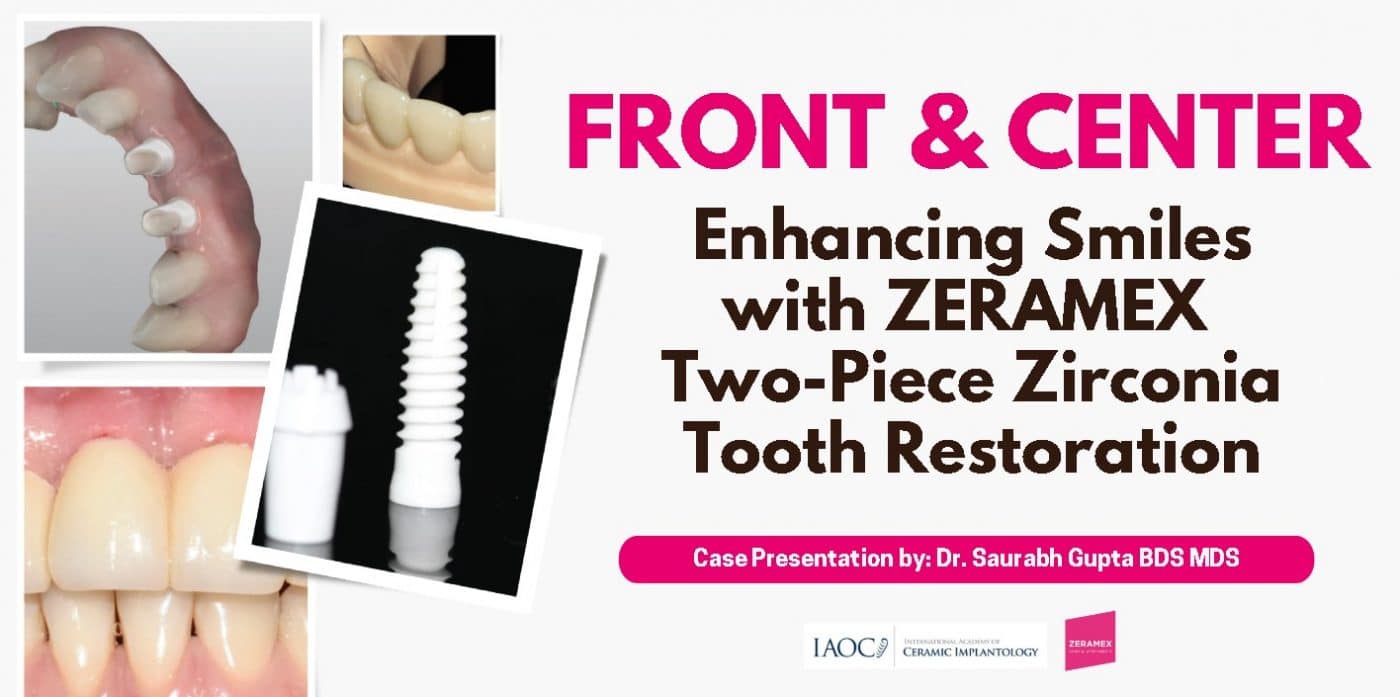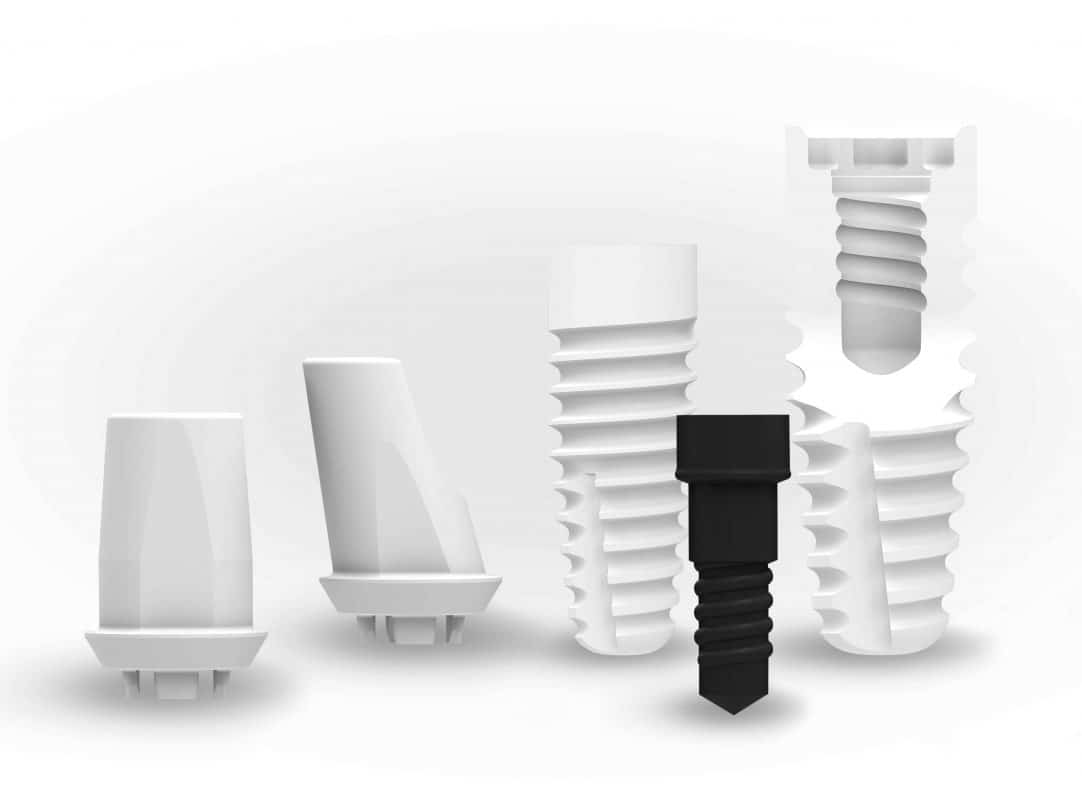
Dr. Saurabh Gupta BDS MDS | Oral & Maxillofacial Surgeon & Implantologist | IAOCI Educational Director | Bangalore · India | Tel.: +91 99 16203455 | saurabh@iaoci.com
Restoration of Aesthetics in the Anterior Tooth Area
Application of two-piece zirconia implants
Zirconia implants are one of the latest developments in dental implantology. Several studies have demonstrated that zirconia implants cause minimal to no inflammation of the peri-implant tissues, while also promoting extended epithelial attachment. Additionally, these implants have a more natural appearance, leading to improved aesthetics. Moreover, they do not contain any metal components, making them ideal for individuals with metal hypersensitivity and patients who prefer metal-free implants.

Fig. 1: Initial situation. Fig. 2: X-ray of the initial situation.
Achieving optimal aesthetic and functional outcomes can be a challenge under normal circumstances with natural teeth. When teeth need to be replaced with implants, especially in the aesthetic zone, the gum tissue can affect the desired result. In patients with thin and/or translucent gingiva, known as the “thin tissue biotype,” the implant may show through, leading to darker gingiva over this area and compromising the patient’s smile aesthetics.
In patients where a front tooth has been missing for an extended period, resulting in resorption of the facial bone plate, even with a thicker gingival type, there is less bone over the implant on the facial side of the ridge. The result is similar to thin gingival types, with a dark shadow over the underlying implant, affecting the aesthetic outcome and not harmonizing with the adjacent soft tissue over natural teeth.
In the following, a clinical case is described that demonstrates the use of a two-piece ceramic implant in the aesthetic zone of the front teeth area.
CASE PRESENTATION
The 44-year-old patient presented to the practice to inquire about replacement options for teeth 11 and 21 (upper central incisors), where a failed partial root canal treatment was present. Additionally, the patient complained about grayish gum tissue around the root-treated teeth and expressed interest in a metal-free solution (Figures 1 and 2). Photos of the natural smile were taken to assess the overall aesthetic concern. Treatment options were discussed with the patient, who, after considering the options, chose to proceed with the extraction of the root-treated tooth and opted for the placement of two-piece zirconia implants along with metal-free crowns.
"When teeth are to be replaced by implants, especially in the aesthetic zone, the gum tissue can affect the desired outcome."
SURGICAL PROCEDURE
During the treatment, both the guidelines for placing zirconia implants in the anterior tooth area and the drilling protocol provided by the manufacturer were followed. It is important to note that the implant site was adequately prepared to avoid excessive torque during implant insertion. Additionally, the use of a tap is necessary. Both the vertical and transverse insertion depth of the zirconia implant are critical for prosthetic success. The implant can be placed between 1.6mm and 0.6mm supra-crestal, as the neck area (0.6mm) is polished smooth. The insertion depth is determined by the height of the gingiva and the available bone around the adjacent teeth.
After atraumatic extraction and laser curettage, two-piece zirconia implants (Zeramex®, Dentalpoint) with a diameter of 4.2x12mm were placed under local anesthesia in the previously occupied sites of teeth 11 and 21. A closure screw was tightened, and the site was closed for healing (Figures 3 and 4). After 72 hours, provisional PMMA crowns were placed (Figure 5).

Fig. 3: Atraumatic extraction (11, 21). Fig. 4a: Subsequent implant insertion Zeramex XT 4.2×12 (11, 21).
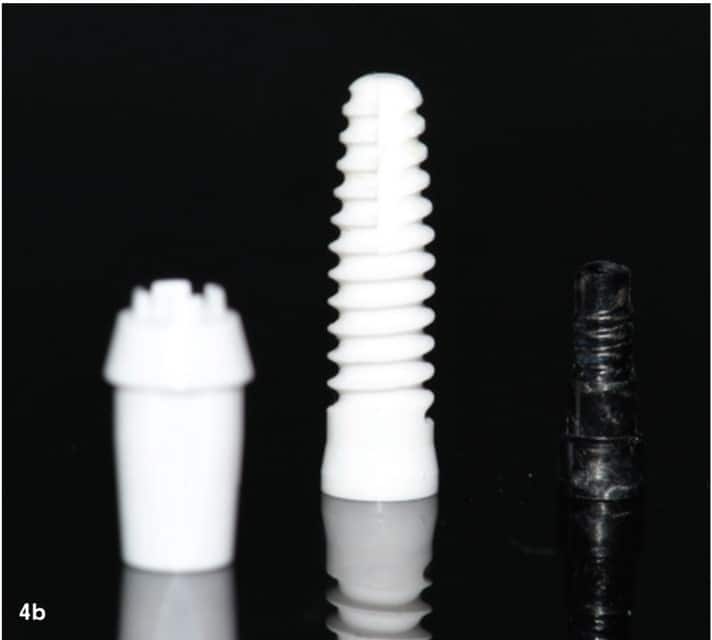
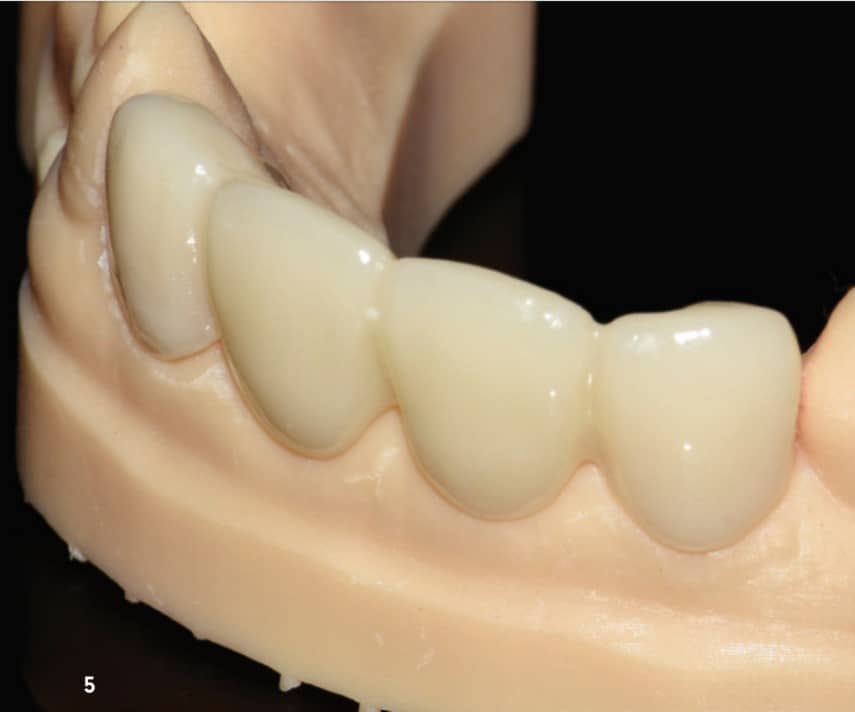
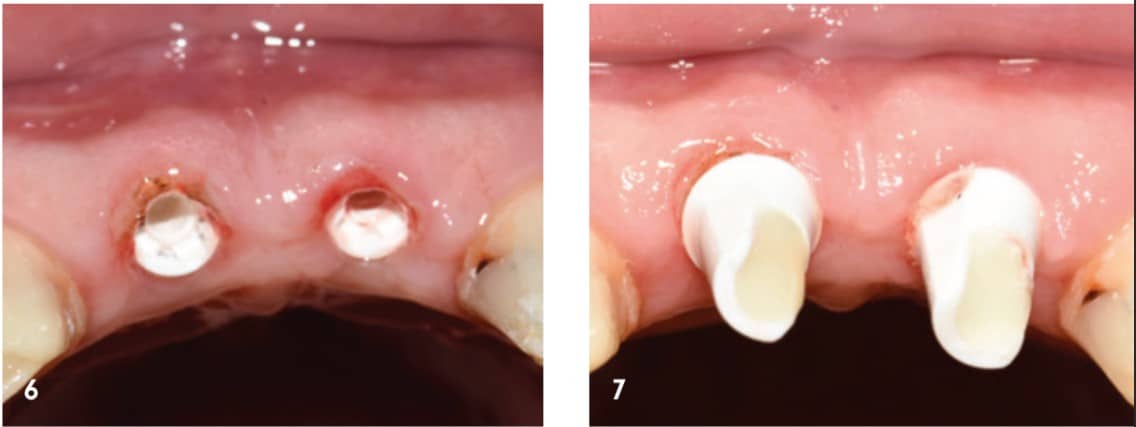
Fig. 4b: Example with Zeramex XT, abutment, and VICARBO screw (completely metal-free solution). Fig. 5: Provisional PMMA crowns placed one week after the procedure. Fig. 6: Healing after four months. Fig. 7: Angulated zirconia abutments in position (15 degrees).
Following a four-month healing phase, a second surgical procedure was performed using a diode laser (940nm). The closure screw was removed, and a gingival former was placed for two weeks. A reduction in inflammation was observed in the soft tissue around the implant, indicating excellent biocompatibility and a favorable patient response (Figure 6). Angulated abutments (15 degrees, Zeramex), also made of ATZ, were placed on the implants using a VICARBO screw (Zeramex XT) (Figures 7 and 8). This carbon-fiber screw, shaped slightly larger than the inner part of the implant, allows for the transmission of chewing forces while ensuring a firm, hermetically sealed connection.
A digital impression was taken for the fabrication of the final crowns to maintain stable soft tissue around the implant (Figure 9). The zirconia ceramic crowns were cemented onto the abutment heads using glass ionomer cement. The completed treatment exhibited a natural aesthetic. The patient received instructions for home oral hygiene and regular check-ups (Figures 10-12).
"A reduction in inflammation was observed in the soft tissue around the implant, indicating excellent biocompatibility and a remarkable patient response."

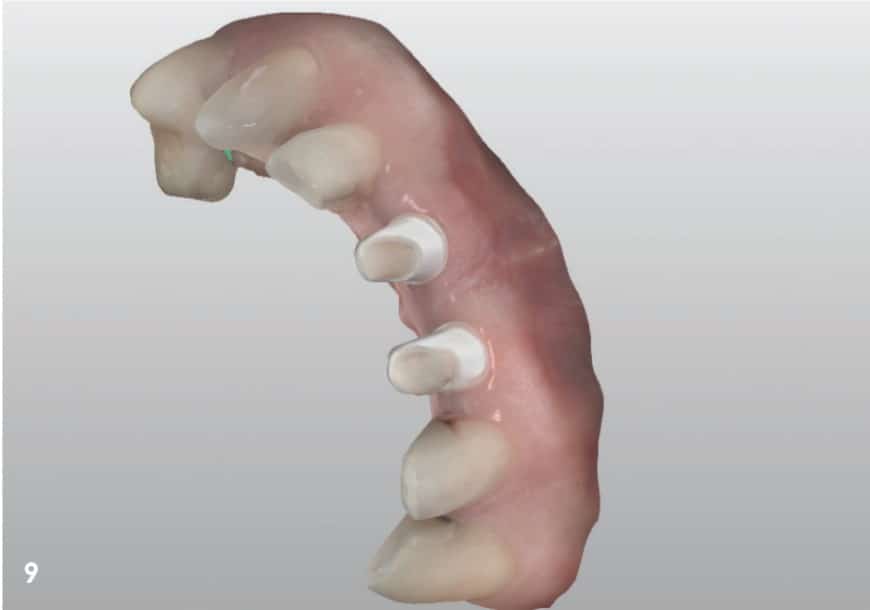
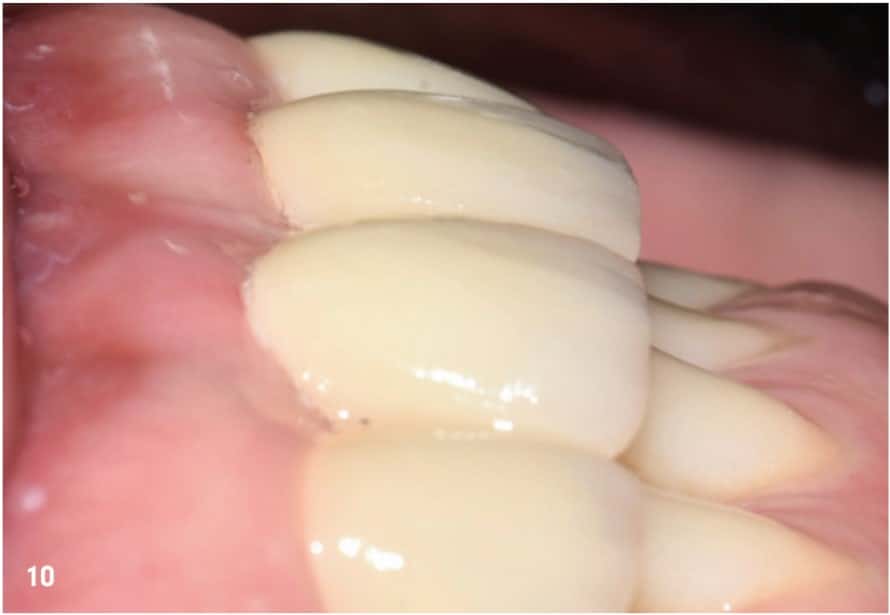
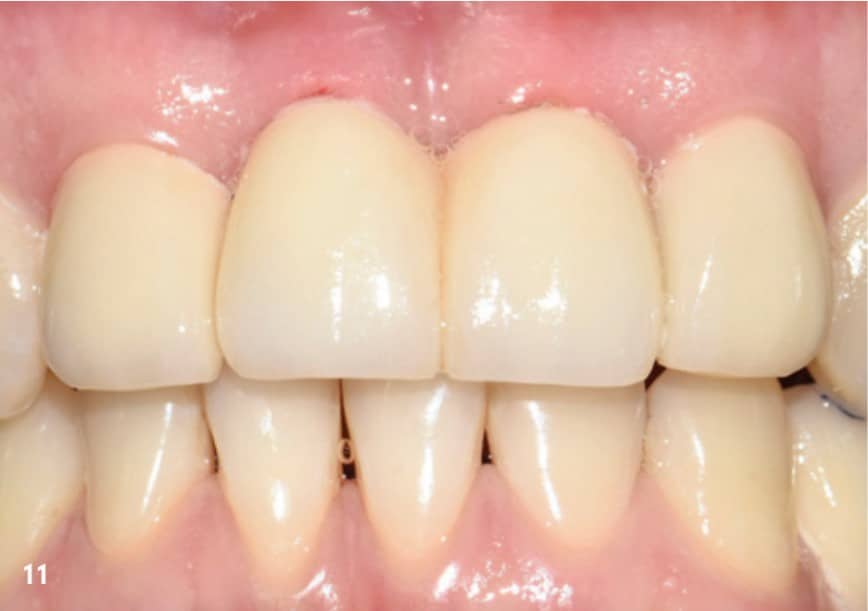
Fig. 8: X-ray image four months after the procedure. Fig. 9: Digital scanning for the fabrication of the crowns. Fig. 10: Zirconia crowns (11, 21) in lateral view. Fig. 11: Zirconia crowns (11, 21) in frontal view.
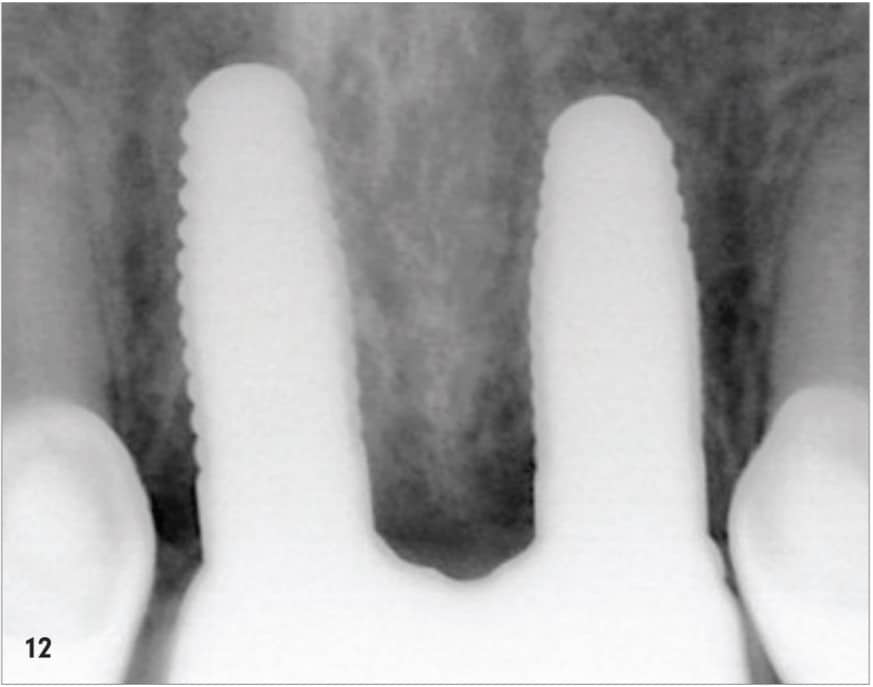
Fig. 12: X-ray image with implants and final crowns.
DISCUSSION
Due to the increasing complications observed in certain clinical situations with the use of titanium dental implants, as well as the rising incidence of peri-implant microsites and peri-implantitis, which impact both the short and long-term survival rates of titanium dental implants, the use of an alternative material, namely zirconia, has demonstrated comparable integration success. Zirconia has been shown to provide superior soft tissue response compared to titanium and exhibits a lower affinity for plaque or biofilm accumulation on its surface compared to titanium.
Furthermore, the peri-implant soft tissue around titanium and zirconia abutments displays color differences in comparison to soft tissue around natural teeth. The peri-implant soft tissue around zirconia demonstrates better color adaptation to the surrounding soft tissue than titanium. This adaptation could be extrapolated to the aesthetic aspect of implant color itself. Zirconia implants can be used in aesthetic situations where the white color prevents potential darkening of the gum tissue and allows for a more natural aesthetic outcome than titanium implants.
However, long-term studies are still necessary to further investigate the efficacy and success rates of two-piece zirconia implants.
ABOUT THE DOCTOR

Dr. Saurabh Gupta is a highly accomplished dental professional with a strong academic background and extensive clinical expertise. He holds a Bachelor’s degree in Dental Surgery (BDS) and a Master’s degree in Dental Surgery (MDS), which reflects his commitment to advancing his skills and knowledge in the field of dentistry.
With a passion for delivering comprehensive dental care, Dr. Gupta has gained significant experience in various areas of dentistry, particularly focusing on advanced treatment techniques and patient-centered care. His dedication to staying updated with the latest advancements in dental science allows him to provide his patients with cutting-edge and evidence-based treatments.
Dr. Gupta’s commitment to his profession is not only reflected in his academic achievements but also in his compassionate approach to patient care. He understands the importance of building strong patient relationships based on trust and open communication, ensuring that each patient receives personalized treatment plans tailored to their unique needs and goals.
Dr. Saurabh Gupta BDS MDS
Oral & Maxillofacial Surgeon & Implantologist
IAOCI Educational Director
Bangalore · India
Tel.: +91 99 16203455
saurabh@iaoci.com
Zeramex Zirconia Implant Systems
At the forefront of ceramic dental implants stands the Zeramex Zirconia Implant Systems, a pioneering innovation in the field. Crafted from high-quality zirconia, a biocompatible and non-metallic material that has undergone extensive research and testing for dental applications, these implants offer unmatched reliability and performance.
The Zeramex Zirconia Implant Systems present a diverse range of implant designs, ensuring precise adaptation to each patient’s unique dental anatomy. With exceptional versatility, dentists can address various clinical cases, from single-tooth replacements to full-arch restorations.
Furthermore, the Zeramex implants feature advanced surface technology that promotes rapid osseointegration, leading to expedited healing and reduced recovery times. Patients can relish the benefits of their new smiles much sooner than with traditional implants.
Learn more about this Metal-free ceramic dental implant by CLICKING HERE.
Contact
Want to know more about Zeramex?
Email us at mfoley@zeramexusa.com with your contact details and we will get in touch with you!
ZERAMEX BROCHURE
Click here to download the Zeramex sales brochure
